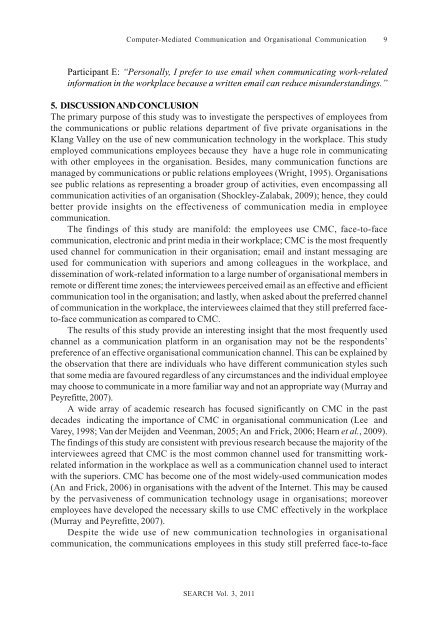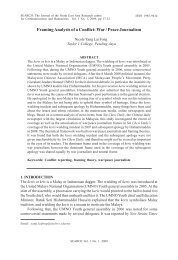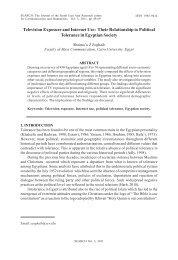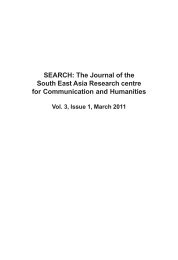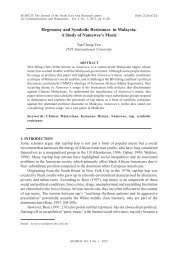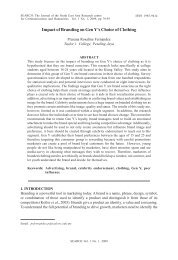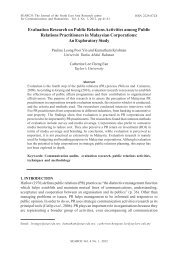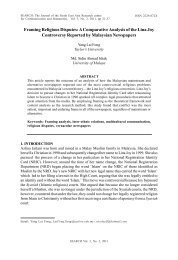Computer-Mediated Communication and Organisational ...
Computer-Mediated Communication and Organisational ...
Computer-Mediated Communication and Organisational ...
Create successful ePaper yourself
Turn your PDF publications into a flip-book with our unique Google optimized e-Paper software.
<strong>Computer</strong>-<strong>Mediated</strong> <strong>Communication</strong> <strong>and</strong> <strong>Organisational</strong> <strong>Communication</strong> 9Participant E: “Personally, I prefer to use email when communicating work-relatedinformation in the workplace because a written email can reduce misunderst<strong>and</strong>ings.”5. DISCUSSION AND CONCLUSIONThe primary purpose of this study was to investigate the perspectives of employees fromthe communications or public relations department of five private organisations in theKlang Valley on the use of new communication technology in the workplace. This studyemployed communications employees because they have a huge role in communicatingwith other employees in the organisation. Besides, many communication functions aremanaged by communications or public relations employees (Wright, 1995). Organisationssee public relations as representing a broader group of activities, even encompassing allcommunication activities of an organisation (Shockley-Zalabak, 2009); hence, they couldbetter provide insights on the effectiveness of communication media in employeecommunication.The findings of this study are manifold: the employees use CMC, face-to-facecommunication, electronic <strong>and</strong> print media in their workplace; CMC is the most frequentlyused channel for communication in their organisation; email <strong>and</strong> instant messaging areused for communication with superiors <strong>and</strong> among colleagues in the workplace, <strong>and</strong>dissemination of work-related information to a large number of organisational members inremote or different time zones; the interviewees perceived email as an effective <strong>and</strong> efficientcommunication tool in the organisation; <strong>and</strong> lastly, when asked about the preferred channelof communication in the workplace, the interviewees claimed that they still preferred faceto-facecommunication as compared to CMC.The results of this study provide an interesting insight that the most frequently usedchannel as a communication platform in an organisation may not be the respondents’preference of an effective organisational communication channel. This can be explained bythe observation that there are individuals who have different communication styles suchthat some media are favoured regardless of any circumstances <strong>and</strong> the individual employeemay choose to communicate in a more familiar way <strong>and</strong> not an appropriate way (Murray <strong>and</strong>Peyrefitte, 2007).A wide array of academic research has focused significantly on CMC in the pastdecades indicating the importance of CMC in organisational communication (Lee <strong>and</strong>Varey, 1998; Van der Meijden <strong>and</strong> Veenman, 2005; An <strong>and</strong> Frick, 2006; Hearn et al., 2009).The findings of this study are consistent with previous research because the majority of theinterviewees agreed that CMC is the most common channel used for transmitting workrelatedinformation in the workplace as well as a communication channel used to interactwith the superiors. CMC has become one of the most widely-used communication modes(An <strong>and</strong> Frick, 2006) in organisations with the advent of the Internet. This may be causedby the pervasiveness of communication technology usage in organisations; moreoveremployees have developed the necessary skills to use CMC effectively in the workplace(Murray <strong>and</strong> Peyrefitte, 2007).Despite the wide use of new communication technologies in organisationalcommunication, the communications employees in this study still preferred face-to-faceSEARCH Vol. 3, 2011


